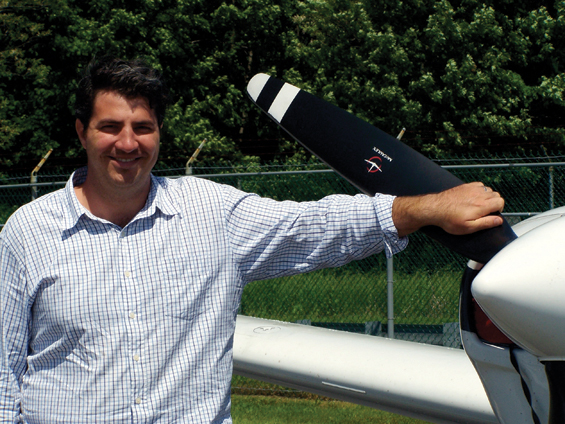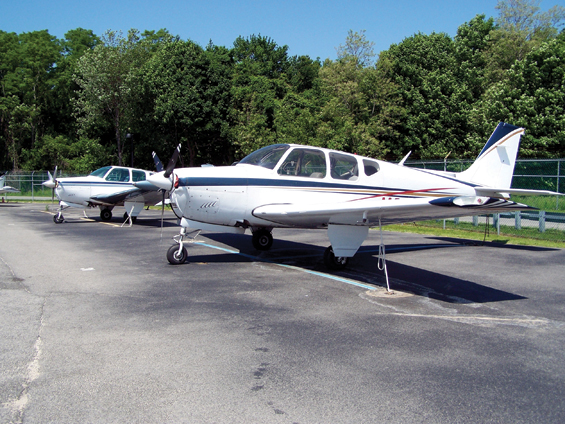Not All Flying Clubs Are Created Equal
 Fly long enough, and unless you are handed the keys to someone else’s airplane on a consistent basis, the buy-vs.-rent dilemma will eventually work its way to the forefront of your aviating consciousness. For the pilots among us who are, shall we say, of means, the decision to buy your own airplane is a snap, and the hard part is deciding on the color. For the rest of us, renting is an easier hurdle, but comes with a long list of hassles that can begin with poorly maintained equipment and end with cleaning the last guy’s lunch out of the seat pocket.
Fly long enough, and unless you are handed the keys to someone else’s airplane on a consistent basis, the buy-vs.-rent dilemma will eventually work its way to the forefront of your aviating consciousness. For the pilots among us who are, shall we say, of means, the decision to buy your own airplane is a snap, and the hard part is deciding on the color. For the rest of us, renting is an easier hurdle, but comes with a long list of hassles that can begin with poorly maintained equipment and end with cleaning the last guy’s lunch out of the seat pocket.
It’s probably for this reason – you want to fly, but don’t want to buy your own plane – that flying clubs were formed. The first modern flying club was probably nothing more than two guys who owned a plane together deciding that by bringing in old one-eyed Joe from the hangar next door, who was 85 and flew once in a blue moon, they’d lower their costs by a third and probably still have all the access they needed. And so it is with most flying clubs today – do the math, and you will find that they can be a cost-effective way to ensure access to aircraft without the downside of either owning outright or renting.
However, not all flying clubs are created equal. Some are constructed to be non-profit, while others specifically intend to make money from their members. Some have too many members spread across too few aircraft, and some have the reverse. A club might have their operations tightly organized and utilize modern technology to manage scheduling, maintenance, or they might be lucky not to be writing tail numbers onto parchment with sharpened feathers. It all makes a difference whether a pilot’s experience with a club is safe, enjoyable and economical.
The Westchester Flying Club (WFC), based at Westchester County Airport (HPN) in White Plains, NY, is a shining example of a club that seems to have gotten everything right. Formed from the merger of two separate groups on the field back in the 1960s, the club now boasts seven aircraft and roughly 70 members – a ten-to-one ratio that figures prominently in how the club is managed. “We are a non-profit, 501c(7) corporation,” explained Brian McCloskey, president of the club. “The club has title to all the aircraft, but the members have equitable ownership.” This means a member has a proportional interest in the club’s assets and any liquidation value.
WFC’s current philosophy is to focus on low-wing aircraft that offer similar handling and avionics. It owns two Archers, two Arrows, a Beechcraft Debonair (with the 285 hp conversion), and two V-tail Bonanzas (an S and a V model, each with 300 hp). All the aircraft are fully IFR-equipped and carry Garmin 480 systems, making the front-office experience consistent across all the club’s planes. “The airframes are a natural progression, with members able to graduate from Piper Archers to Bonanzas as their flying abilities and mission requirements change,” adds McCloskey. Members need 350 hours and an IFR rating to fly the 300-hp aircraft, and 150 hours for the Arrows. “Our members can generally use any instructor they want,” says McCloskey. “I think our members enjoy the flexibility and consistency of hiring their own instructor and essentially training in their own plane.”

The business end of any flying club is where things can get tricky, but WFC is straightforward and efficient. Like most clubs, WFC passes costs onto its membership. But unlike many, it runs at or very close to break-even. Joining, costs $1600, of which $600 is refunded when a member leaves. Fixed costs are determined on an annual basis and divided by the number of members, resulting in a monthly charge (currently $185). Once in the cockpit with the engine running, members are charged according to tach time and model – as of June, it was $87 per hour for the Archers and $165 for the V-Tails (the rates fluctuate up and down each month with the price of avgas). All hourly costs are calculated wet, i.e. including fuel. The club has extensive operating data on the costs to operate each aircraft, so usage fees are calibrated very closely. Finally, the club carries a restricted cash balance at all times to handle engine overhauls, avionics upgrades, cosmetics, etc., another factor that keeps the group from being overwhelmed by the higher-ticket, more intermittent aspects of owning airplanes. In addition, the club tries to stay reasonably abreast of advances in technology, and has started looking into retrofitting the aircraft with glass avionics due to lower total cost of ownership, reliability and safety.
“Frankly, we don’t compare ourselves to rentals or other clubs with low monthly operating costs,” notes McCloskey. “They’re very often subsidized by tons of members, but have no availability. We’re really more of a self-managed, quasi-fractional ownership program embodied in a non-profit flying club. We’d like to keep that 10-to-1 ratio, because over the years we’ve learned that availability suffers past that number. At 80 members, we’d be looking to add another plane to the fleet.”
Also unlike many clubs, WFC aircraft can be used for serious travel. Members can book planes for as much as two weeks at a stretch, and many members use WFC aircraft for business travel. The club’s aircraft mix ensures that performance rivals that of any new Cirrus or Cessna at the altitudes people really fly, and it is very cost-effective for business owners who have to travel any appreciable distance to have access to an 180-knot aircraft available for days at a time.
The club meets on the second Tuesday of every month at the Valhalla Crossing restaurant in Valhalla, NY., about ten minutes from the airport. “Meetings can be…passionate,” says McCloskey, with a slight pause for emphasis. “Everyone is a pilot, and pilots are not typically shy individuals. But we all have a vested interest in making sure the club is run well and that the planes are flown & maintained appropriately, so differences are usually ironed out quickly. We’re very lucky – everyone gets along, and regardless of background or profession, everyone understands that you have to treat something like a 40-year old airplane with respect.”
The club is organized along typical lines, with elected officers (President, VP, Secretary and Treasurer) comprising the board and handling everything from membership to finances. Maintenance coordinators are assigned to each plane, giving a central point of contact for everything regarding a particular aircraft’s hangar needs, from inspections to oil changes, and scheduling is done online. In addition, a central message board creates an efficient way for the membership to communicate with one another between meetings, discussing squawks, TFR’s, and so on.
For pilots looking to visit a new airport restaurant once a month, renting makes the most sense. For those with the means, owning ensures complete control over every aspect of an aircraft. But for everyone else in the middle, a flying club makes the most economic sense. WFC has few of the more common issues one hears about regarding clubs – availability is paramount, safety is the primary concern and bylaws & operating rules are stringent. It’s a well-managed club with well-maintained aircraft and a membership that exudes the kind of airfield camaraderie for which flying is famous. And for the first time in several years, WFC does not have a waiting list. For more information check them out at www.wfc-hpn.org, or contact the club’s Vice President, Ron Weinstein, at ron.weinstein@gmail.com





